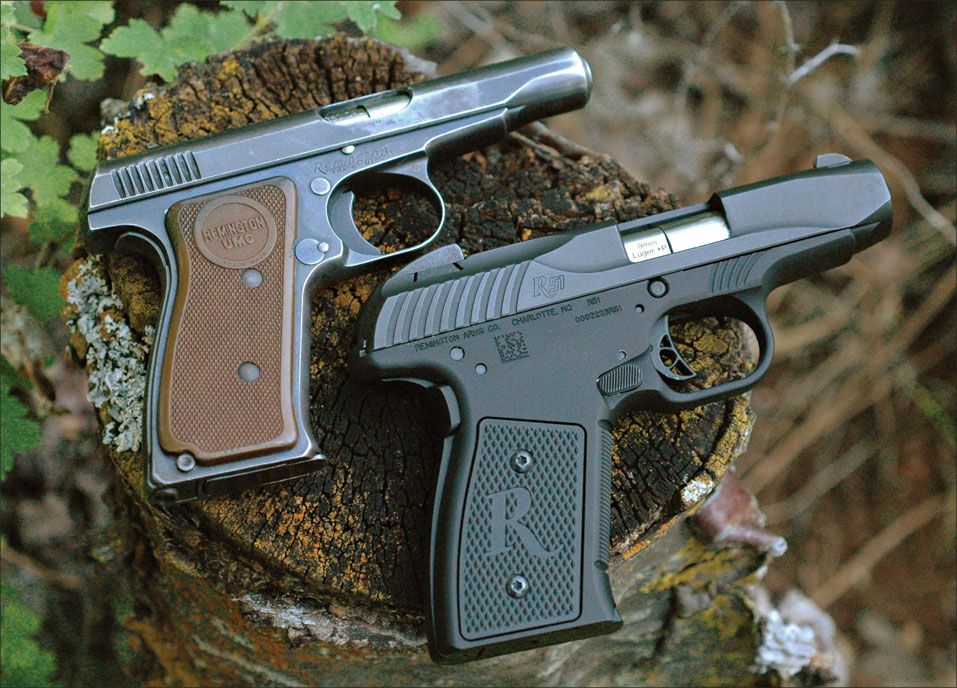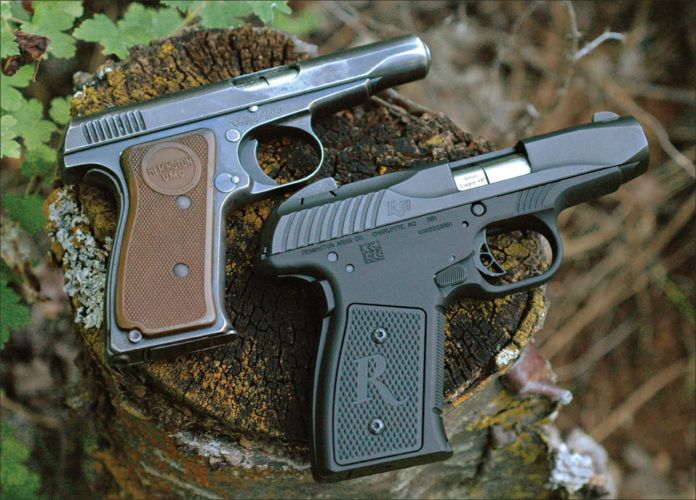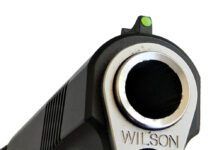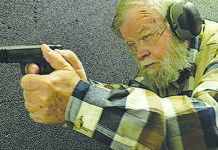Just before WWI, John Pedersen of Remington UMC designed a pistol of 45 ACP caliber that featured an outside hammer and a delayed recoil system that drastically reduced the felt recoil. A Navy Board recommended adopting it, but the arms factories were already geared up to make the Model 1911, so this Remington 45-caliber pistol never went into production. During the war the Pedersen Device was produced. It made the bolt-action Springfield rifle into a semi-automatic one, firing a low-powered 30-caliber round. The device did not have a locked breech, but the pistol did. Pedersens mechanism locked the round in the chamber as the chamber and slide moved rearward. When the bullet left the barrel and pressure dropped, the fired case was pulled out of the chamber, ejected, and another round put in. The system worked extremely well, and Mr. Pedersen used the same design for the Remington 51 pistol after the war.

After WWI Remington entered the automatic pistol market with the innovative new Model 51 pistol in 380 ACP and 32 ACP. From 1918 to 1927 (some sources say into the 1940s) Remington manufactured the Model 51 semi-automatic pistol. Remingtons new pistol apparently didnt catch on that well, though the pistols were well thought of by those who used them. Today, Remington has essentially revised the old Pedersen pistol design in the new R51, a 9mm pistol using the same floating-chamber concept. We were able to acquire both a sample of the new R51 and one of the original Model 51s in 380. When the Model 51 came out just before 1920, its price was under $16. With the dollar worth roughly 1/25th as much today, the new Remington R51, with a price just over $400, is in the same general price range as the original. We took a good look at the two pistols, shot them, and liked the R51 quite a lot, despite problems other shooters were having with it. Then in late July, Remington recalled the entire R51 production run, which meant we had to fail the R51 in our grading scheme.
Remington Model 51 380 ACP, about $500
The Model 51 was available in two calibers, 32 ACP or 380 ACP. We borrowed an original M51 in 380 ACP from T. R. Graham, The Glocksmith (TheGlockSmith.com, [832] 695-7192), based in Benbrook, Texas. Our example was in good condition, with about 70 percent of its original bluing remaining. There was some minor pitting or scratching along the slide, but all in all this was an outstanding usable example of the Model 51.
The brown-checkered plastic grips each had the Remington UMC trademark stamp on them. The single-stack magazine held eight rounds. A button on the left side of the grip released the magazine, but the magazine did not fall free. It had to be pulled out once released. There was a grip safety, hinged at the bottom like that of the R51. There was also a pivoting thumb safety that basically blocked the grip safety. The top of the slide was cross-serrated to cut glare, and it held the following message in all capital letters: The Remington Arms Union Metallic Cartridge Co. Inc., and on a second line, Remington Ilion Wks., Ilion, N.Y. U.S.A. Pedersens Patents Pending.
The slide had integrally machined sights, which were simply horrid. They had the right idea behind them, but were microscopic in size. They consisted of a square-notch rear and a square-top post front. The width of the rear notch was 0.030 inch. The front sight was 0.052 inch wide and 0.034 inch high. The grip angle was similar to that of the new R51, and like the R51 the Model 51 sat low in the hand and pointed well. However, the slide was not held rearward once the last round was fired. You can, however, lock the slide rearward if you can manage to release the grip safety while holding the slide all the way back. The grip safety will pop out and hold the slide rearward. Our first look at the barrel showed it to be in sad condition. We therefore expected no great accuracy from the gun.
You cannot fire the gun if the magazine is all the way out. If its part-way out, the gun can indeed be fired. The grip safety actually serves as a cocking indicator because it doesnt pop out until the gun is cocked. It also blocks several things internally, so theres no danger of the gun firing if dropped, hit with a sledgehammer, or run over by a truck.
The outside of the barrel had serrated cuts near the muzzle, also found on the new R51, as well see, because they are basically the same internal design and takedown is somewhat similar for the two. There was a small, easily removed cross pin that went through the frame just below the slide. It was clearly the beginning of the field-stripping procedure. We found the takedown procedure was similar to that for the R51, but we strongly advise you to first go online to www.how-to-DIY.org and plug in this search: Field Stripping, Remington 51 Pistol before you try to take the gun apart. That video was helpful, but we found the slide would not come off until we pressed the grip safety. That was unclear in the video. Also not perfectly clear was the need to force the barrel forward and then twist it counterclockwise (looking at the muzzle) to lock it out of the way so you can get the sliding breech out of the gun. The video made it look too easy. Without a good long look at either that video or detailed instructions in a proper disassembly manual, we would not advise that Gun Tests readers attempt to take this gun apart.
The disassembly video doesnt show the removal of the barrel, which is perhaps a good idea. The barrel comes out just like on the R51, but its not easy to get it out or back in. Heres a tip: Leave the barrel in the slide to clean it. Heres another tip if you choose to remove the barrel from the slide: Wear safety goggles. Also, plan to have lots of time available to you the first time you try this. A vise was helpful.
On the range we found the Remington 51 to be a pleasant gun to shoot, except for its trigger. We also found this gun did not work properly with the full magazine of eight plus one up the stack. With just eight rounds in the gun, it worked perfectly. The 51 pointed extremely well, the result of long testing by the manufacturer early in the 20th century before the gun went into production. The gun sits low in the hand and recoil was very light. This systems recoil mechanism absorbs some of the felt recoil.
Accuracy was more than acceptable, given the corroded state of the barrel. Rapid firing was joyful, the double taps all centering the target at about seven yards. In slow fire the gun was a disappointment because of the pathetic sights and the lousy trigger. The trigger was extremely heavy and didnt break at the same weight for any two shots. The trigger pull averaged 8.2 pounds, but varied in break from 7.5 to 9.1. This gave us fits, but the gun still shot three types of ammo well enough, we thought, and it handled them perfectly. We shot Remington 95-grain MC, Winchester 95-grain PDX Defender JHP, and TUL (Russian) 91-grain FMJ. Groups varied from 2.6 to over 7 inches at 15 yards. There were no problems except for a failure to feed when we loaded eight plus one. If the owner could find a barrel in better condition, the guns accuracy might improve, but it was not bad as it was, all things considered. Surely no one would carry one of these collectors items today.
As for its value, we found samples for sale online from $485 to $1000, the latter price for one in like-new condition. One at $485 and another at $500 both had excellent barrels. One had about the same amount of blue remaining as this one, and one was refinished.
Our Team Said: We thought this was a very interesting handgun, fun to shoot, no fun at all to field strip, but a fine example of an early design. It was the inspiration for the new R51. We gave it Grade B for cosmetics and function. We gave it Grade A+ for interest, pointing, and comfort; and Grade D for its trigger pull. Just dont load any more than the magazine holds, build up the muscles in your trigger finger, and youll have lots of fun with this one. Overall, Grade B.
Remington Model R519mm Luger, $420
For us, this new 9mm handgun seemed to be just the right size for its power. The grip safety kept things simple. If you have a good grasp on the gun, you can fire it. If you dont, you cant. There are also internal passive safety devices ensuring the gun will not fire when firing is undesired, as when its dropped. The finish was flat black. The slide was made of steel and the frame of aluminum. The only obvious plastic parts were the trigger and the magazine follower. The slide had pleasing contoured cuts, which took away unneeded metal. It also had good bold cuts on the back for traction so you could chamber a round easily.
The sight picture was excellent with three white dots and enough light around the big front blade. The sights were big and bold, and easy to see. The top-rear edge of the dovetailed front-sight blade was slightly rounded so it wont catch on your clothing. The rear sight was kept snag-free on the draw by its curved top and blended sides, which ran to the back of the slide. We thought this was a clever idea that was also attractive. All in all, Remington did an excellent job of dehorning this pistol. The front grip strap was beautifully checkered and the grip was big enough for most hands to get all the fingers on it. The only controls on the gun were the grip safety, the trigger, the magazine release, and the slide stop, which was also the key to the odd takedown procedure. The magazine release was ambidextrous, though not easy to get to in a hurry. We would have liked taller buttons.
Heres a tip: Dont try to field strip this gun until you read and understand the owners manual. Weve never seen anything like this takedown procedure, except for the Model 51. The first odd thing we noticed was the serrated area around the barrel, which led us to ask ourselves, Why is that there? Then we read the book and understood. In short, you have to grab and hold the barrel while you pull the slide off the gun and the guts out of the slide. Inside we found Remington had upgraded the 51s fussy loose firing pin and spring. In this new gun they come and go with the breech block. It was also a lot easier to get the gun apart, though the removal and replacement of the barrel and its spring were not exactly exercises in simplicity.
The action of the gun is unusual, to say the least. As the slide is withdrawn, it moves easily for a short distance and then the force needed to move it drastically increases. Thats the breech block hitting the cam. Then the slide moves easily again until near the end of its travel, and then becomes hard to move. The gun features a floating breech block that moves with the outgoing cartridge until the block encounters a delay in the form of a cam that bumps the breechblock upward, permitting the block to again move rearward with the slide and withdraw the spent case from the chamber. This cam gives a delayed action that lets the pressure in the barrel drop before the cartridge is pulled out of the chamber. One of the benefits of this design is the spring force to move the slide is relatively light. Another is a drastic decrease in felt recoil.
The mechanism depends on the timing and force of the pressure curve of the ammunition for proper operation. If you have a too-strong pulse, or if the peak pressure pulse comes at the wrong time in the cycle of the slide, it could potentially cause problems with the gun. That, we presume, is why Remington advises the use of either Remington or Barnes ammo only, and that of course is why we tried other types. Be aware that some 9mm ammo is ferociously high-pressure stuff, so one really ought to listen to Remington and use only the recommended ammunition. We tried a few Remington 115-grain JHP rounds on hand, then tested it with On Target 115-grain FMJ, Winchesters Bonded PDX-1 124-grain JHP, and U.S.-made HPR 124-grain JHP. We had no Barnes ammo on hand.
The magazine body was easily wide enough to accept 45 ACP cases. Second-guessing Remington, we would love to see a 45 on this concept, but thats speculation. At this point all thats being made is this 9mm version. At any rate the 9mm rounds had plenty of room inside the magazine box, and loading the mag was easy enough.
On the range all the ammo seemed to work well enough. The slide stayed back after the last shot. The magazine fell freely out of the gun when released, and we could fire the gun with the magazine removed. Then we began to have problems. We found the HPR rounds would not go easily into the chamber, and were really hard to extract from the chamber unfired. However, we could not fault the gun because of that problem because it was not a brand of ammo that Remington had specified. We had no other problems with the Remington until we tried to load seven in the magazine and one more in the chamber. The gun ships with two magazines, which Remington designates 7+1 magazines on its website catalog. This procedure jammed the second round in the magazine on one of our first tries. But we could not get the gun to repeat that failure, so put it down to newness. In fact, we tried hard to get it to fumble eight rounds again, but it never failed. The gun fired as quickly as we could operate it, and the smooth trigger always worked.
So is this gun viable, with its limited ammo types? As long as the system is understood and the correct ammo used, the gun worked perfectly. It must have ammunition that has the proper pressure curve or peak to function correctly, and Remington tells you this. However, the limited ammo availability is a substantial flaw for most shooters who will want their pistols to function with a variety of 9mm-stamped ammo.
Near the end of our test we fired a round of the wrong ammo, and when it failed to eject properly we looked at the fired case closely. It was badly bulged from pressure. That was definitive proof for us that you MUST use the ammo Remington calls for in this gun. No exceptions! If a round with either a too-low, too-high or too-late pressure curve fails to extract or bursts in the just-opening gun, that means you have not read the manual, and its your fault. When we saw that bulged case, we were vividly shown exactly why Remington needs you to use only the specified ammo types. For most shooters, this will be disqualification enough to pass on the R51.
We were disappointed in the guns accuracy, but it showed signs of improvement the more we shot. The average of all our five-shot groups was a little over 4 inches at 15 yards. As our testing progressed we saw more clusters of three tight rounds out of each five-shot group, so there was hope for improvement. We got some abrasion on our hand, but this wont be a problem if you dont need to shoot it as much as we did. The slide never touched us. The R51 shot everything about 4 inches low at 15 yards. Many of our readers will say that’s middling accuracy at best, and they have to weigh what is “good enough” for a lightweight self-defense pistol at short distances.
We thought the size, shape, and weight of the pistol were all excellent. We could get our whole hand on the grip for great control, the gun sat low in the hand, and it pointed well for us.
Our Team Said: The Remington R51 was a handy, comfortable pistol of just the right size for its power. Felt recoil with the hottest ammo was amazingly light, and muzzle flip was almost non-existent. It had an odd takedown procedure that was easily mastered. The gun had enough accuracy for its intended purpose. It worked well, was not too expensive, had a great trigger and great sights, and we really liked the concept.
Though our FFL advised us that other shooters were having function problems, our test gun simply did not exhibit those problems. Because we only report what happens in our tests and base our grades on our own experiences, we could not fault the R51 for issues other people were having.
However, after publication of the August print issue, we learned that the R51 had been recalled by Remington. We adjusted the grade on the R51 to an F and have returned our test gun to the factory under the recall program. When the repaired gun returns in October, according to Remington’s factory instructions, we will compare the “before” performance of the R51 to the “after” performance once the pistol has been fixed under the recall.
Written and photographed by Ray Ordorica, usingevaluations from Gun Tests team testers. GT






























